Arturia SparkLE, Spark 2 User Manual

Information contained in this manual is subject to change without notice and does not represent a commitment on the part of ARTURIA. The hardware unit and the software product described in this manual are provided under the terms of a license agreement or non-disclosure agreement. The license agreement specifies the terms and conditions for its lawful use. No part of this manual may be reproduced or transmitted in any form or for any purpose other than purchaser’s personal use, without the explicit written permission of ARTURIA S.A. All other products, logos or company names quoted in this manual are trademarks or registered trademarks of their respective owners.
© ARTURIA SA – 1999-2014 – All rights reserved. 30, Chemin du Vieux Chêne
38240 Meylan FRANCE
http://www.arturia.com
March 2014 – 2.0 edition
ARTURIA – SPARK CREATIVE DRUM MACHINE – USER’S MANUAL |
2 |

PROJECT MANAGER
Kevin Molcard
PRODUCT MANAGER
Glen Darcey
PROGRAMMING
Kevin Molcard (Lead Developer) |
Philippe Wicker |
Emilie de Fouchecour |
Vincent Travaglini |
Bruno Pillet |
Niccolo Comin |
Adrien Courdavault |
Guillaume Piolat |
Tobias Carpenter |
|
ELECTRONICS |
|
|
|
Laurent Baret |
|
Bruno Pillet |
|
DESIGN |
|
|
|
Glen Darcey |
|
Sebastien Rochard |
|
Morgan Perrier |
|
Shaun Ellwood (Decoder Design) |
|
SOUND DESIGN |
|
Noritaka Ubukata |
Pierce Warnecke |
Jean-Michel Blanchet |
Oliver Fauque |
Christian Lafitte (Cigale Prod) |
Thomas Koot |
Mike Hosker |
Glen Darcey |
Kevin Shröder |
Hernan Velasco |
Greg Savage |
Stéphane Schott |
INDUSTRIALIZATION |
|
|
|
Nicolas Dubois |
|
Richard Phan |
|
Gerard Buracchini |
|
MANUAL WRITING |
|
|
|
William Talgorn |
Randy Lee |
Sebastien Rochard |
|
MANUAL TRANSLATION |
|
|
|
Tomoya Fukuchi |
Pierce Warnecke |
Jérome Parrod |
Sébastien Rochard |
ARTURIA – SPARK CREATIVE DRUM MACHINE – USER’S MANUAL |
3 |

SPECIAL THANKS
Sean Weitzmann, Gérard Buracchini, Cedric Pallier, Elodie Cao, Denis Frouin, Philippe Girard-Buttoz, Yannick Bonnefoy, Peter Gelhaus (acoustic drum kit photo), Kevin Lamb, Patrick Kunz, Frank Orlich, Miguel Silva, Houston Haynes, Cristian Kreindler, Paul Steinway Sébastien Rochard, Tobias Carpenter, Hung Lee, Jason Huang, Wenyu Huang, Matty Yuan, Chen Xiaomai
SOUND SAMPLES
ARTURIA – SPARK CREATIVE DRUM MACHINE – USER’S MANUAL |
4 |
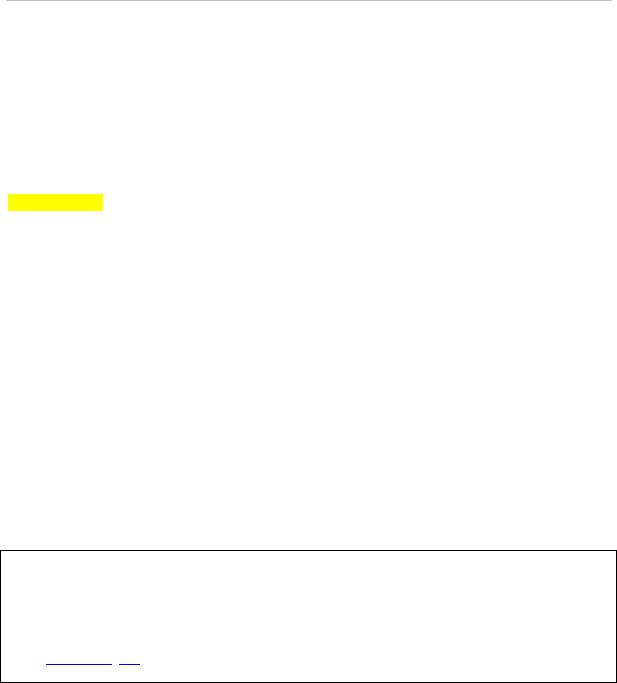
Thank you for purchasing Spark!
This user manual covers three distinct products:
Spark software, a highly creative beat production center
Spark Creative Drum Machine controller
SparkLE controller
The manual concentrates on two main areas (hardware and software) with occasional
“side-chains” to focus on the specific functionality of each controller and its unique approach to controlling the software.
In most cases, the information in one chapter will be sufficient to cover both controllers. Occasionally a chapter will be split into two sections: one describing the Spark Creative Drum Machine controller and a second describing the SparkLE controller, with all other sections describing the Spark software they both were designed to control (hereafter referred to as the Spark Engine).
Package Contents (hardware version)
In this package you will find:
A DVD-ROM containing Spark Creative drum machine installer for Mac OS X and Windows 7/Vista/XP
A registration card with the Serial Number and Unlock Code (Spark Creative), or a sticker inside the Quick Start guide with that information (SparkLE).
The User’s Manual for Spark Creative Drum Machine software and the Spark
Controller
Spark Creative controller or SparkLE controller (depending on the model)
USB cable
Be sure to store your registration information carefully! It contains the serial number and unlock code that are required to register and authorize the Spark Engine, so these codes are valuable.
It’s important to register because this identifies you as the legitimate owner and ensures that you’ll receive the latest news and updates for your software and hardware.
See chapter 2 “Registration & Authorization” for more information about the authorization process.
ARTURIA – SPARK CREATIVE DRUM MACHINE – USER’S MANUAL |
5 |
Special Message Section
The Spark controller uses USB or an external power adapter. Do not connect this product with any other power supply or adapter than the one specifically recommended by
Arturia in this manual.”
WARNING:
Do not place this product in a position where someone could walk on, trip over or roll anything over power or connecting cords.
The use of an extension cord is not recommended! If you must use one, make sure the cord has the ability to handle the maximum current needed by this product. Please consult a local electrician for more information on your power requirements.
This product should be used only with the components supplied or recommended by Arturia. When using this product with any approved components, please observe all safety markings and instructions that accompany the accessory products.
SPECIFICATIONS SUBJECT TO CHANGE:
The information contained in this manual is believed to be correct at the time of printing. However, Arturia reserves the right to change or modify any of the specifications without notice or obligation to update existing units.
IMPORTANT:
Always follow the basic precautions listed below to avoid the possibility of serious injury or even death from electrical shock, damages, fire or other risks.
The product used either alone or combined with an amplifier, headphones or speakers, may be able to produce sound levels that could cause permanent hearing loss. DO NOT operate for long periods of time at a high level or at a level that is uncomfortable.
If you encounter any hearing loss or ringing in the ears, you should consult an audiologist.
NOTICE:
Service charges incurred due to a lack of knowledge relating to how a function or feature works (when the unit is operating as designed) are not covered by the manufacturer’s warranty, and are therefore the owner's responsibility. Please study this manual carefully and consult your dealer before requesting service.
ARTURIA – SPARK CREATIVE DRUM MACHINE – USER’S MANUAL |
6 |
PRECAUTIONS INCLUDE, BUT ARE NOT LIMITED TO, THE FOLLOWING:
Read and understand all the instructions.
Before cleaning the instrument, always remove the electrical plug from the outlet, and detach the USB cable.. When cleaning, use a soft and dry cloth. Do not use gasoline, alcohol, acetone, turpentine or any other organic solutions; do not use a liquid cleaner, spray or cloth that's too wet.
Do not use the instrument near water or moisture, such as a bathtub, sink, swimming pool or similar place.
Do not place the instrument in an unstable position where it might accidentally fall over.
Do not place heavy objects on the instrument. Do not block openings or vents of the instrument; these locations are used for air circulation to prevent the instrument from overheating. Do not place the instrument near a heat vent or any place with poor air circulation.
Only use the recommended specified AC adaptor (9 Vdc, 800 mA)
Make sure the line voltage in your location matches the input voltage specified on the AC power adaptor.
Do not open and insert anything into the instrument that may cause a fire or electrical shock.
Do not spill any kind of liquid onto the instrument.
Always take the instrument to a qualified service center. You will invalidate your warranty if you open and remove the cover, and improper assembly may cause electrical shock or other malfunctions.
Do not use the instrument with thunder and lightning present; it may cause long distance electrical shock.
Do not expose the instrument to hot sunlight.
Do not use the instrument if there is a gas leak nearby.
Arturia is not responsible for any damage or data loss.
HANDLING CD-ROMS:
Avoid touching or scratching the shiny underside (encoded surface) of the disc. A damaged or dirty CD-ROM disc may not read properly. Keep your CD-ROMs clean using a commercially available CD cleaner.
ARTURIA – SPARK CREATIVE DRUM MACHINE – USER’S MANUAL |
7 |
Table of Contents
1 |
INTRODUCTION ......................................................................................................................................... |
9 |
|
|
1.1 |
WELCOME TO SPARK................................................................................................................................. |
9 |
|
1.2 |
HISTORY.................................................................................................................................................... |
9 |
2 |
REGISTRATION & AUTHORIZATION ................................................................................................ |
11 |
|
3 |
THE SPARKLE CONTROLLER: AN OVERVIEW .............................................................................. |
12 |
|
|
3.1 |
THE FRONT PANEL .................................................................................................................................. |
12 |
|
3.2 |
SIDE PANEL (OVERVIEW) ........................................................................................................................ |
14 |
4 |
THE SPARK CREATIVE CONTROLLER: AN OVERVIEW.............................................................. |
15 |
|
|
4.1 |
THE FRONT PANEL .................................................................................................................................. |
15 |
|
4.2 |
REAR PANEL (OVERVIEW) ...................................................................................................................... |
17 |
5 |
USING SPARK: The Software Interface................................................................................................... |
18 |
|
|
5.1 |
THE TOOLBAR ......................................................................................................................................... |
18 |
|
5.2 |
THE MAIN PANEL (SPARKLE).................................................................................................................. |
19 |
|
5.3 |
THE MAIN PANEL (SPARK CREATIVE) ................................................................................................... |
30 |
|
5.4 |
THE SEQUENCER PANEL.......................................................................................................................... |
45 |
|
5.5 |
THE SONG PANEL .................................................................................................................................... |
50 |
|
5.6 |
THE STUDIO ............................................................................................................................................ |
52 |
|
5.7 |
THE MODULAR........................................................................................................................................ |
56 |
|
5.8 |
THE MIXER ............................................................................................................................................. |
66 |
|
5.9 |
THE LIBRARY .......................................................................................................................................... |
79 |
|
5.10 |
PREFERENCES PANEL............................................................................................................................. |
81 |
6 |
MODES OF OPERATION ......................................................................................................................... |
83 |
|
|
6.1 |
STANDALONE MODE ............................................................................................................................... |
83 |
|
6.2 |
PLUG-IN MODE........................................................................................................................................ |
85 |
|
6.3 |
VST ........................................................................................................................................................ |
86 |
|
6.4 |
AUDIO UNIT (MAC OS X ONLY) ............................................................................................................. |
88 |
|
6.5 |
PRO TOOLS.............................................................................................................................................. |
91 |
|
6.6 |
RECORDING MIDI OUT FROM SPARK INTO A HOST DAW........................................................................... |
92 |
|
6.7 |
CONTROLLING SPARK WITH AN EXTERNAL MIDI CONTROLLER ...................................................... |
95 |
7 |
THE SPARK CONTROLLERS ................................................................................................................. |
96 |
|
|
7.1 |
USING THE CONTROLLER WITH THE SPARK ENGINE................................................................................ |
96 |
|
7.2 |
USING THE CONTROLLER WITH HOST APPLICATIONS OR MIDI DEVICES ................................................. |
97 |
|
7.3 |
MIDI CONTROL CENTER....................................................................................................................... |
98 |
8 |
SPARK LEGAL INFORMATION ............................................................................................................ |
99 |
|
|
8.1 |
SOFTWARE LICENSE AGREEMENT ............................................................................................................ |
99 |
|
8.2 |
FCC INFORMATION (USA) .............................................................................................................. |
101 |
|
8.3 |
CANADA ............................................................................................................................................. |
102 |
|
8.4 |
EUROPE .............................................................................................................................................. |
102 |
9 |
NOTES........................................................................................................................................................ |
103 |
|
ARTURIA – SPARK CREATIVE DRUM MACHINE – USER’S MANUAL |
8 |

1 INTRODUCTION
1.1 WELCOME TO SPARK
BEAT THE FUTURE
Combining the power of analog synthesis, physical modeling and samples through the intuitive workflow of a hardware drum machine, Spark is a highly creative beat production center. Spark will save you time when looking for the right drum kit and will get you hooked by its amazing ease-of-use and sonic possibilities.
Spark embeds vintage analog drum machines, sample based beatboxes and REX loop playback. Spark’s engine further allows you break through their sonic boundaries thanks to a highly tweakable controller.
With in-depth control over your sounds, an advanced loop mode and an XY touchpad
with 8 real time effects, Spark will allow you to create unique beat experiments and constantly feed your creativity with innovative ideas.
Spark’s sonic power is nothing but huge, embedding three distinctive drum engines: analog synthesis, sampling and physical modeling. Thanks to the automations available on all parameters, every kit is very tunable and customizable, bringing a fun and complementary approach to sample browsing while making it more interactive and userfriendly than similar products.
Incorporating a 16-step sequencer and 8 velocity-sensitive touch pads into a sturdy beat station, Spark is your weapon of choice to bring the best groove into your tracks whether you are working in the studio or performing on stage.
1.2 HISTORY
Early in 2001 Arturia began working on advanced algorithms for the digital emulation of analog circuit audio characteristics. They are known as TAE®, standing for True Analog Emulation. In non-technical terms, this is an unprecedented way of creating the very unique sound one finds in a synthesizer such as the Bob Moog’s ones. Nearly a year after they began work on the algorithms, Arturia was ready for feedback. At the 2002 NAMM show in California, Arturia shared an early version of what would later be the Modular V with the renowned maker of the original synthesizer, Doctor Bob Moog.
In seeking insight from sound production experts such as Dr. Moog, as well as avid synthesizer users, Arturia was able to ensure the quality of the instruments they made; so well in fact that Dr. Moog himself endorsed the Modular V. The launch of this sound powerhouse was an instant success, winning awards from several top magazines, and leading to the development of other synth recreations.
Shortly thereafter, Arturia started receiving many requests from musicians, producers and bands. Many of them explained how they were planning to replace their original hardware synthesizers with virtual instruments. Artists around the globe were beginning to see the advantages of a software alternative to hardware-based synthesizers.
The CS-80V emulated the legendary Yamaha CS-80, considered by many as "the ultimate polyphonic" synthesizer, and was launched at the AES 2003 in New York. Imagine some of your favorite music from diverse artists such as Keith Emerson or Stevie Wonder, and you'll get an idea of the capabilities of CS-80V.
ARP 2600V was launched at the Winter NAMM Show 2005 in Anaheim. This is a faithful reproduction of the ARP 2600 and is great for just about any sound one might wish to
ARTURIA – SPARK CREATIVE DRUM MACHINE – USER’S MANUAL |
9 |
create: everything from drum n’ bass stabs to Star Wars’ R2-D2 sounds have been made with the ARP.
At the Winter NAMM Show 2006, ARTURIA announced the release of its seventh product: the Prophet V. This powerful hybrid gives you two instruments in one: it combines the warmth of the legendary Prophet 5 programmable analog synth with the unique Vector Synthesis textures of the digital Prophet VS.
The next year at the summer 2007 NAMM Show Arturia launched the Jupiter-8V. In terms of sonic possibilities, it complemented its “Arturian siblings” by bringing something different to the table. The Jupiter-8V is capable of creating very versatile sounds: You could easily make ‘fat’ or ‘crystal’ sounds with it. In fact, Jupiter-8V sounds the way it originally looked: ‘sleek and polished’.
The electro-pop community quickly became convinced by the qualities of the original Jupiter-8. Artists that have used the Jupiter-8 include: Thomas Dolby, Tangerine Dream, Jean Michel Jarre, Depeche Mode, Prince, Kitaro, Elvis Costello, Duran Duran, Huey Lewis and the News, Journey, Yes, Devo, Billy Idol, Jan Hammer and BT, to name a few!
Recognizing the commitment artists the world over had to the sound of the Jupiter-8, Arturia took great pains with Jupiter-8V to maintain absolute faithfulness to the sonic characteristics of the beloved instrument while also following our penchant to allow users to venture well beyond its original capabilities.
Then in the year 2011 Arturia introduced the SPARK Creative Drum Machine. This powerful hybrid instrument was aimed at the producer and the live beat maker. It proposed a unique workflow mixing the 16-step style of programming with the live approach of pads, filtering, slicing and looping functions. Taking advantage of its expertise in virtual analog, Arturia not only integrated emulations of classic analog drum machines, but also acoustic drums, physical models, and powerful electronic kits all rolled up in one easy-to-use interface. Spark was quickly and widely used by top producers and artists such as Sandy Vee, the Glitch Mob, the Mars Volta, Vitalic, DJ Quick, and Yeasayer.
In 2013 Arturia continued its innovative streak with the introduction of the SparkLE hardware controller and version 1.6 of the SPARK Creative software. This powerful combination offers all of the acclaimed features of SPARK Creative software while maintaining an intuitive workflow all its own.
Finally, at the 2014 winter NAMM show, Arturia announced the version 2.0 of Spark software, with a totally new GUI interface as well as many new features including an improved sequencer, song mode, and a full modular synthesis interface for infinite sound creation possibilities.
We are certain the SPARK Creative Drum Machine will take its place at the heart of your creative endeavors.
ARTURIA – SPARK CREATIVE DRUM MACHINE – USER’S MANUAL |
10 |

2 REGISTRATION & AUTHORIZATION
Once the Spark has been installed, the next step is to register the software.
The registration process will require you to enter the serial number and the unlock code you received with the product.
In order to proceed, go to this web page and follow the instructions:
http://www.arturia.com/register
Note: If you don’t have an Arturia account yet, you will need to create one. The process is quick, but it does require that you can access your e-mail address during the registration process.
Once you have acquired an Arturia account you will be able to register the product.Once you have acquired an Arturia account you will be able to register the product.
ARTURIA – SPARK CREATIVE DRUM MACHINE – USER’S MANUAL |
11 |
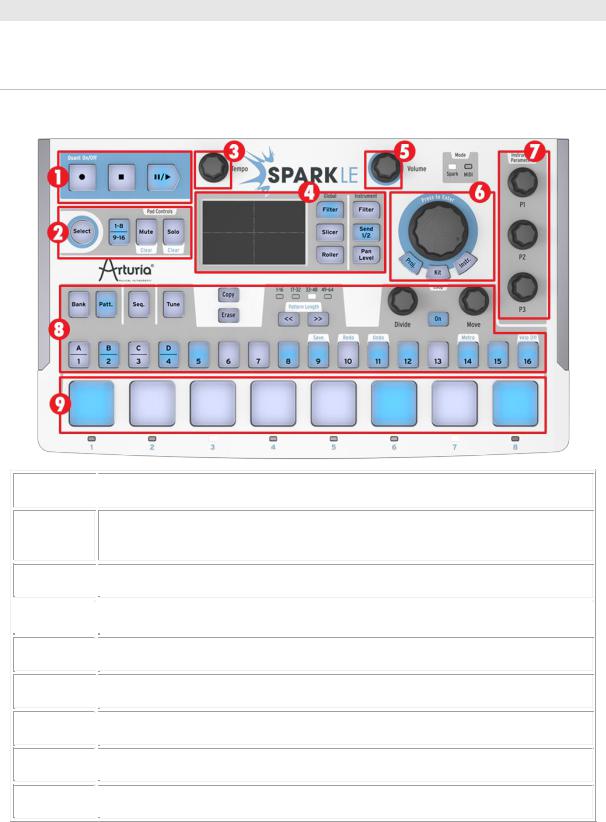
3 THE SPARKLE CONTROLLER: AN OVERVIEW
3.1 THE FRONT PANEL
In this overview we will focus on the features specific to the hardware controller.
1.
 Transport zone
Transport zone
2.Pad controls: Select Instrument / Shortcut, Toggle Instrument page (1-8, 9-16), Mute and Solo buttons
3.
 Tempo knob
Tempo knob
4 |
|
FX Live pad and FX Selection buttons |
|
|
|
5.
 Master Volume control knob
Master Volume control knob
6.
 Jog Dial and Project / Kit / Instrument mode buttons
Jog Dial and Project / Kit / Instrument mode buttons
7.
 Instrument parameter knobs
Instrument parameter knobs
8.
 Sequencer zone
Sequencer zone
9.
 Instrument pads
Instrument pads
3.1.1 The Transport zone
Record, play, pause or stop a pattern or song with these buttons.
ARTURIA – SPARK CREATIVE DRUM MACHINE – USER’S MANUAL |
12 |
3.1.2 The Pad controls
The buttons in this zone can select an Instrument, execute a Shortcut, switch between two pages of Instruments in the kit, and Mute and/or Solo instruments on the fly.
3.1.3 The Tempo knob
Use this knob to adjust the tempo of your pattern or song.
3.1.4 The FX Live pad
Real-time control of performance effects on an X/Y axis. Three buttons toggle Global effects (Filter, Splicer, Roller) and three more control effects for the selected Instrument.
The Select button can lock one effect’s position while a second effect is performed.
3.1.5 The Master Volume knob
This knob controls the overall output level.
3.1.6 The Jog Dial and Mode buttons
The Jog Dial allows you to access the library and load Instruments, Kits and Projects. Used with the Select button you can apply search filters while selecting Instruments.
Use the Project, Kit and Instrument buttons to access the according library browser directly. Use the jog dial and the select button to browse kits, projects, instruments or samples:
Scrolling the Jog Wheel will let you navigate the result list. Clicking on the Jog Wheel will load the highlighted element.
Scrolling the jog wheel while the “Select” button is pushed will navigate the list of filters.
Clicking on the jog wheel will activate/deactivate the current filter.
Click and hold the Jog Wheel, then scroll it to select a different browser (Project, Kit, Instrument or Disk).
Hold the “Select” button and click on the Jog Wheel for 1 second to close the browser window without loading anything.
3.1.7 The Instrument parameter knobs
Select three parameters per instrument to tweak during recording or playback.
3.1.8 The Sequencer zone
Used for selecting and editing patterns and assembling and editing songs, the Sequencer zone also gives you the ability to alter loops in real time. You can also make quick chromatic tuning adjustments to the selected Instrument.
3.1.9 The Instrument pads
The pads allow you to play multiple instruments at the same time from one set of eight instruments, and the 1-8 / 9-16 page button can toggle between the other set of eight instruments in the current kit. Use the Mute and Solo buttons to silence one or more Instrument tracks or bring others to the forefront of the mix.
ARTURIA – SPARK CREATIVE DRUM MACHINE – USER’S MANUAL |
13 |

3.2 SIDE PANEL (OVERVIEW)
1.
 USB Mini-B connector
USB Mini-B connector
2.
 Kensington lock slot
Kensington lock slot
3.2.1USB connector
Use the supplied USB cable to connect the SparkLE controller to your computer’s USB 2.0 port. SparkLE is bus-powered, so no additional power supply is needed.
3.2.2 Kensington lock slot
SparkLE is highly portable, so this slot will allow an added degree of security.
ARTURIA – SPARK CREATIVE DRUM MACHINE – USER’S MANUAL |
14 |
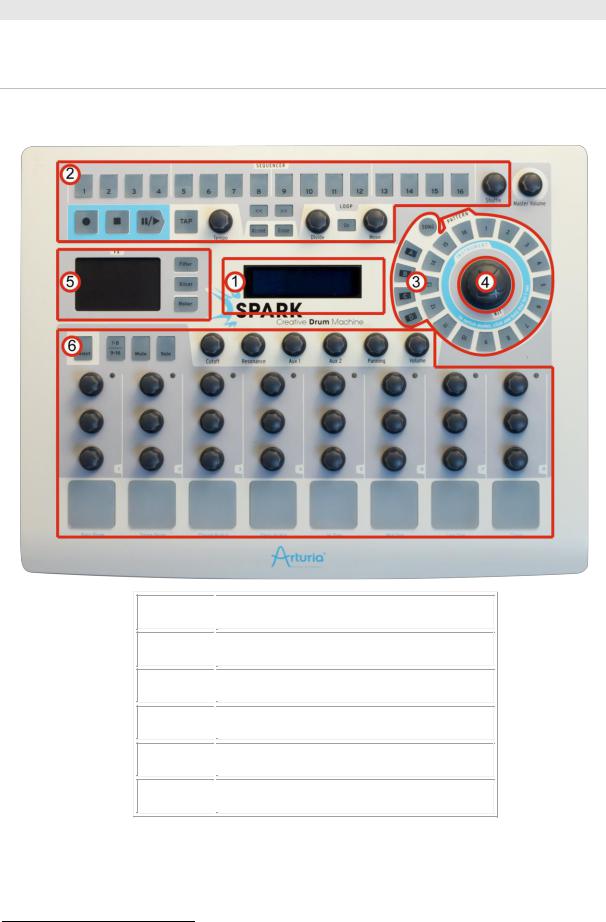
4 THE SPARK CREATIVE CONTROLLER: AN OVERVIEW1
4.1 THE FRONT PANEL
The Spark Creative controller looks the same as its Center panel in the Spark Engine. In this overview we will focus on the features specific to the hardware controller.
1.
 Display
Display
2.
 Sequencer zone
Sequencer zone
3.
 Song/Pattern zone
Song/Pattern zone
4.
 Jog Dial
Jog Dial
5.
 FX Live pad
FX Live pad
6.
 Instrument control zone
Instrument control zone
1
ARTURIA – SPARK CREATIVE DRUM MACHINE – USER’S MANUAL |
15 |
4.1.1 The display
Fittingly placed at the center of the Spark Creative controller, the display is the central source for all information about what the controller is doing.
4.1.2 The Sequencer zone
Used for viewing, assembling and editing patterns and songs, the Sequencer zone also gives you the ability to alter loops in real time.
4.1.3 The Song/Pattern zone
All of Spark Creative’s 64 patterns can be accessed quickly from this zone. They are arranged in four banks of 16 patterns each (A-D and 1-16). The buttons also light up to tell you which pattern is currently playing.
4.1.4 The Jog Dial
The Jog Dial allows you to access the library and load Instruments, Kits and Projects. When used with the Select button, you can apply search filters while selecting Instruments.
Use the jog dial and the select button to browse kits, projects, instruments or samples:
Scrolling the Jog Wheel will let you navigate the result list. Clicking on the Jog Wheel will load the highlighted element.
Scrolling the jog wheel while the “Select” button is pushed will navigate the list of filters.
Clicking on the jog wheel will activate/deactivate the current filter.
Click and hold the Jog Wheel, then scroll it to select a different browser (Project, Kit, Instrument or Disk).
Hold the “Select” button and click on the Jog Wheel for 1 second to close the browser window without loading anything.
4.1.5 The FX Live pad
Real-time control of a ton of performance effects such as filter and resonance, volume and panning, aux sends, bit reduction, stutter effects, etc. Three buttons in this zone toggle the Filter, Splicer and Roller effects and cycle through their many variations. One effect can be locked in mid-modulation by the Select button while a second effect is performed.
4.1.6 Instrument Control zone
Play the pads and tweak the parameters of one or more instruments at the same time, either while recording a track or while playing back a pattern or song. Select between two banks of instruments and mute or solo them using the buttons in this zone.
ARTURIA – SPARK CREATIVE DRUM MACHINE – USER’S MANUAL |
16 |

4.2 REAR PANEL (OVERVIEW)
1.
 USB connector
USB connector
2.
 MIDI IN port
MIDI IN port
3.
 MIDI OUT port
MIDI OUT port
4.Power supply
9Vdc, 800 mA, center positive
5.
 Power on/off switch
Power on/off switch
4.2.1USB connector
This connects to your computer’s USB 2.0 port for the exchange of data and for electrical power. In addition to allowing you to control the Spark Engine this port can also take MIDI data from the outside world and feed it to your computer, and vice versa.
4.2.2 MIDI In port
Use this port to send MIDI data from an external device into your computer.
4.2.3 MIDI Out port
This port not only sends MIDI data from your computer to external devices, it allows you to use the Spark Creative controller to control those external devices via MIDI.
4.2.4 Power supply (optional)
Connect the Spark controller to a powered USB 2.0 port. That will supply enough power to run the controller.
Note: You should not use the controller with a non-powered USB hub.
If you prefer to power your Spark Creative controller with a separate power supply, plug it in here. Be sure to use one with the right specifications, though: 9 volts DC, 800 mA, and center positive.
4.2.5 Power on/off switch
Use this to toggle the Spark Creative controller on or off.
ARTURIA – SPARK CREATIVE DRUM MACHINE – USER’S MANUAL |
17 |
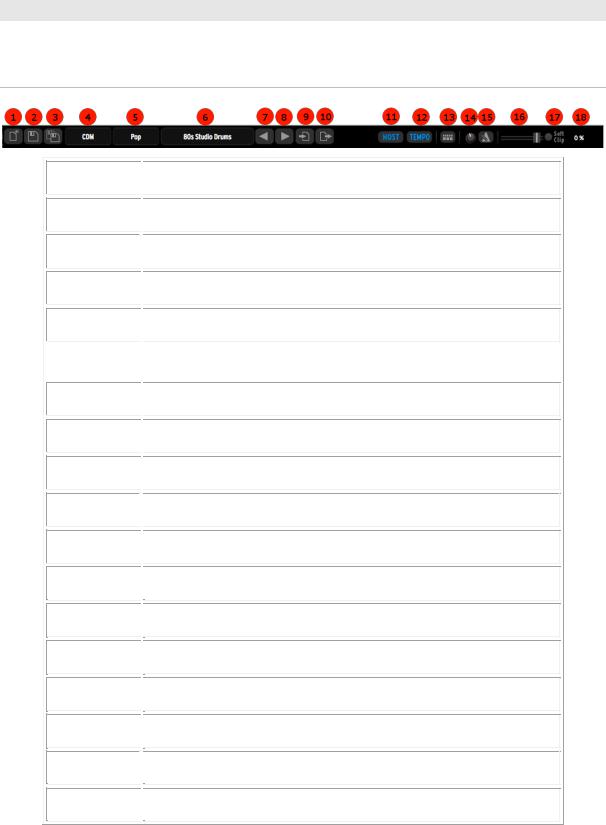
5 USING SPARK: The Software Interface
5.1THE TOOLBAR
1.
 New project
New project
2.
 Save
Save
3.
 Save as
Save as
4.
 Bank selection
Bank selection
5.
 Musical genre selection
Musical genre selection
6 |
|
Project selection |
|
|
|
7.
 Previous project
Previous project
8.
 Next project
Next project
9.
 Import project
Import project
10.
 Export project
Export project
11.
 Sync playback with Host (only in Host mode)
Sync playback with Host (only in Host mode)
12.
 Sync tempo with Host (only in Host mode)
Sync tempo with Host (only in Host mode)
13.
 ‘Connect hardware’ switch (only in Host mode)
‘Connect hardware’ switch (only in Host mode)
14.
 Metronome volume
Metronome volume
15.
 Metronome on/off
Metronome on/off
16.
 Main volume fader and vu meter
Main volume fader and vu meter
17.
 Soft clipping on/off
Soft clipping on/off
18.
 CPU consumption
CPU consumption
ARTURIA – SPARK CREATIVE DRUM MACHINE – USER’S MANUAL |
18 |
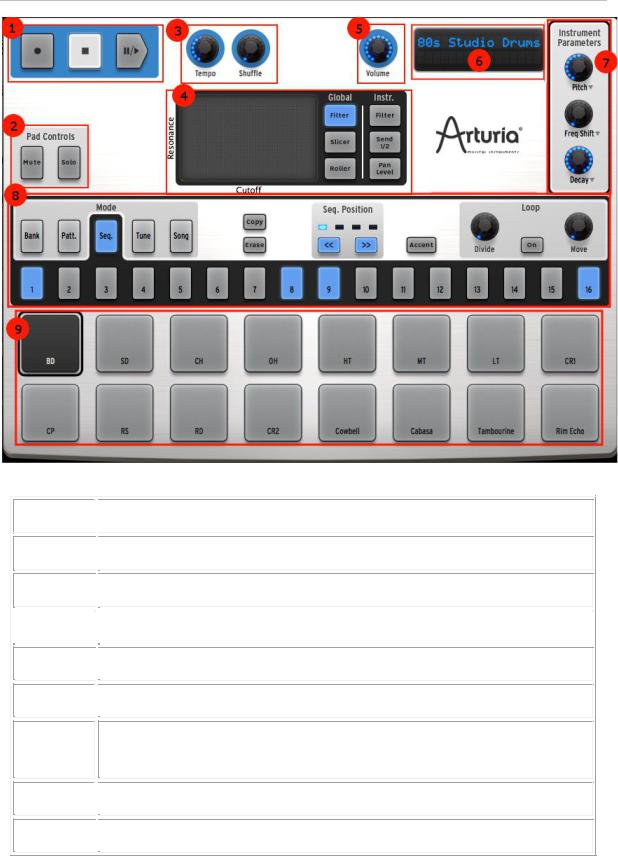
5.2 THE MAIN PANEL (SPARKLE)
1.
 Transport zone
Transport zone
2.
 Mute and Solo buttons
Mute and Solo buttons
3.
 Tempo and Shuffle control knobs
Tempo and Shuffle control knobs
4 |
|
FX Live pad and FX Selection buttons |
|
|
|
5.
 Master Volume control knob
Master Volume control knob
6.
 Current project display
Current project display
7.Instrument parameter knobs (right-click: edit motion/disable motion)
8.
 Sequencer zone
Sequencer zone
9.
 Instrument pads (right-click to edit the instrument)
Instrument pads (right-click to edit the instrument)
ARTURIA – SPARK CREATIVE DRUM MACHINE – USER’S MANUAL |
19 |
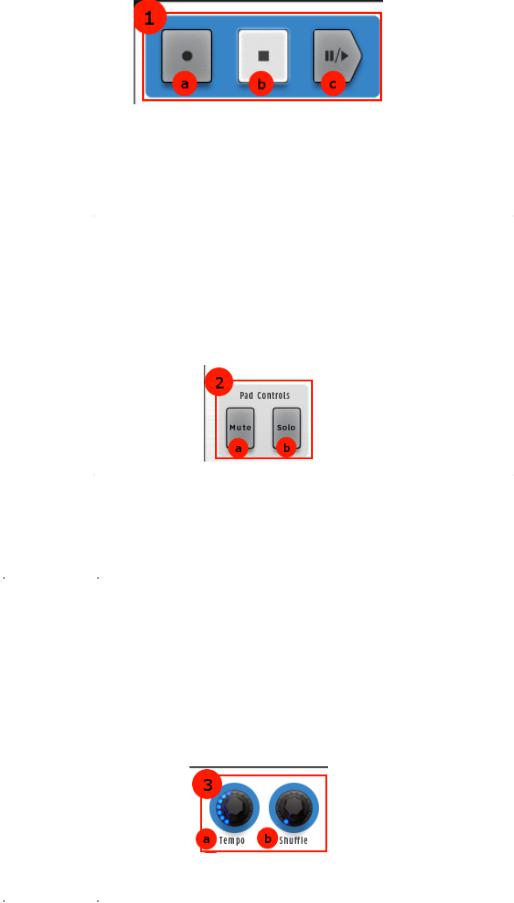
5.2.1 The Transport zone
|
|
|
|
|
|
1.a |
|
Record button (right-click to select quantized/unquantized |
|
|
|
|
recording) |
|
|
|
|
|
|
|
|
|
|
|
|
1.b |
|
Stop button |
|
|
|
|
|
|
|
|
|
|
|
|
1.c |
|
Play / Pause button |
|
|
|
|
|
|
|
|
|
|
|
Record, Stop, Play & Pause: the functions seem obvious. But this is a Transport with a twist: Right-click the Record button and you can select whether you want the next pass to be recorded with quantization or without.
5.2.2 The Pad Controls zone
|
|
|
|
|
|
|
|
2.a |
|
|
Mute button (click Mute, then select one or more |
|
|
|
|
|
|
instruments) |
|
|
|
|
|
|
|
|
|
|
|
|
|
|
|
|
|
2.b |
|
|
Solo button (click Solo, then select one or more |
|
|
|
|
|
|
instruments) |
|
|
|
|
|
|
|
|
|
|
|
|
|
|
|
|
Mute |
|
Click this button and then one or more Instrument pads to mute them. |
||||
|
|
Click Mute again to unmute those pads. Use Select + Mute to clear all |
||||
|
|
mutes. |
||||
Solo |
Click the Solo button and then select one or more pads to silence the other |
|||||
|
|
tracks so you can focus on the ones you want to hear. Click Solo again to |
||||
|
|
return the pads to their previous state. Use Select + Solo to clear the solo |
||||
|
|
status. |
||||
5.2.3 The Tempo / Shuffle zone
|
|
|
|
|
|
3.a |
|
Tempo control knob |
|
|
|
|
|
|
|
|
|
|
|
ARTURIA – SPARK CREATIVE DRUM MACHINE – USER’S MANUAL |
20 |
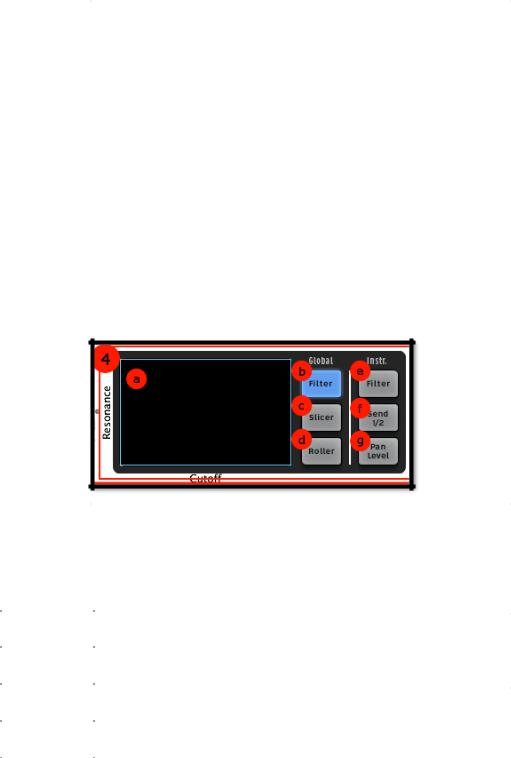
|
|
|
|
|
|
|
|
|
|
3.b |
|
|
Shuffle amount knob |
|
|
|
|
|
|
|
(right-click: Swing range / Velocity emphasis) |
|
|
|
|
|
|
|
|
|
|
|
|
|
|
|
|||
Tempo |
For slower tempos turn this knob to the left; for faster tempos turn the |
||||||
|
|
|
knob to the right. |
||||
Shuffle |
Sets the amount of shuffle applied to a pattern. Shuffle is a rhythmic |
||||||
|
|
|
effect in which the duration of the first note in a series of two notes is |
||||
|
|
|
lengthened and the duration of the second note is shortened. This is also |
||||
|
|
|
known as setting the “swing amount.” |
||||
|
|
|
For a higher shuffle amount turn this knob to the right; for less shuffle |
||||
|
|
|
turn the knob to the left. |
||||
|
|
|
Right-click on the Shuffle knob to define the timing value on which the |
||||
|
|
|
shuffle will be applied (1/8, 1/16, or 1/32 note). |
||||
|
|
|
The right-click menu also shows the Velocity emphasis option, which |
||||
|
|
|
increases the dynamic range between the shuffled notes and ‘fixed’ notes. |
||||
5.2.4 The FX Live pad and Effect buttons
|
|
|
|
|
|
4.a |
|
FX Live pad (X/Y axis control surface) |
|
|
|
|
|
|
|
|
|
|
|
|
4.b |
|
Global Filter button (right-click: Latch or Touch operation) |
|
|
|
|
|
|
|
|
|
|
|
|
4.c |
|
Global Slicer button (right-click: Latch or Touch operation) |
|
|
|
|
|
|
|
|
|
|
|
|
4.d |
|
Global Roller button (right-click: Latch or Touch operation) |
|
|
|
|
|
|
|
|
|
|
|
|
4.e |
|
Instrument Filter button |
|
|
|
|
|
|
|
|
|
|
|
|
4.f |
|
Instrument Aux Send 1 / 2 button |
|
|
|
|
|
|
|
|
|
|
|
|
4.g |
|
Instrument Pan / Level button |
|
|
|
|
|
|
|
|
|
|
|
5.2.4.1 FX Live pad
The FX Live pad is an amazing performance tool that will apply real-time effects to your song or patterns. It features three main effect buttons (Filter, Slicer and Roller) with an amazing variety of options. When your cursor enters the FX Live pad area it becomes a cross; click and hold the cursor and drag it around while a pattern is playing and you’ll begin to get an idea of what this zone can do for your music.
By right-clicking any of the Global effect buttons you can choose between "Latch" or "Touch" performance for that effect. "Latch" will hold the effect at its current value when
ARTURIA – SPARK CREATIVE DRUM MACHINE – USER’S MANUAL |
21 |
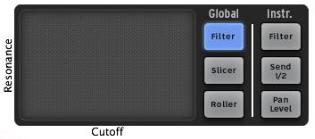
you release the cursor; "Touch" will cut off the effect when the cursor is released (i.e., the effect is only active when you are clicking on the Pad).
You can also enable Latch mode from the hardware controller by pressing and holding the Select button and then pressing the Filter, Slicer or Roller button.
In Latch mode you can combine the Filter and Slicer effects: To “slice” the filtered sound, set the filter effect to Latch mode. Now you can touch the pad and change your filter to the desired setting. Next enable the Slicer button. The Filter will remain at its last value while you play the Slicer on the FX Live pad.
Note that the Roller effect is not active when Slicer is set to Latch mode.
5.2.5 Live effects: Global
5.2.5.1 The Filter Button
The Filter button offers proprietary Low pass, Band pass and High pass filters, plus Oberheim-style Low, High, Band pass and Multi-mode filters, each with cutoff and resonance.
To select a filter type, click on the Filter button repeatedly. You’ll see the display cycle through the options; just stop clicking when you reach the one you want. You can also access the one you want directly by keeping the Filter button pressed and moving your cursor or finger to the filter type you want to select.
The cutoff frequency and resonance can be modulated with the mouse in the Spark Engine or with your finger on the FX Live pad of the hardware controller.
The resonance is modulated vertically (up and down, or along the Y axis), and the cutoff frequency is modulated horizontally (from right to left, or along the X axis).
Play a pattern and click or touch anywhere on the right edge of the FX pad while maintaining your click or touch; draw a straight horizontal line towards the left side of the FX pad. You will hear the cutoff frequency sweeping downward. The amount of modulation applied can be seen on the center display panel.
Now place the cursor somewhere on the right half of the FX pad and trace a line straight up to the top edge of the pad. You are modulating the resonance.
Of course, both cutoff and resonance can be modulated simultaneously by moving your finger or the mouse in any direction and at any speed you wish.
5.2.5.2 The Slicer button
The Slicer will grab a portion of the pattern and apply the effect you have chosen repeatedly at the timing value you select with the FX Live pad (except for the Tape effect, which only happens once per press). Multiple presses of the Slicer button will allow you to choose between the following effects:
ARTURIA – SPARK CREATIVE DRUM MACHINE – USER’S MANUAL |
22 |
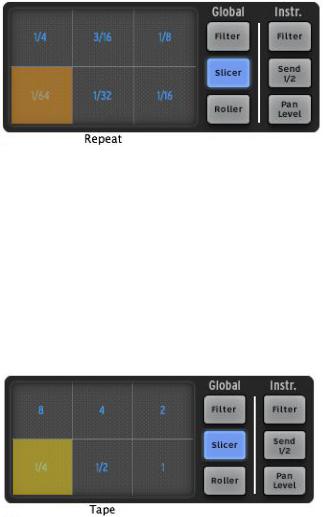
Repeat
Slicer example 1: Repeat effect options
Click to choose a timing value for the Repeat effect. If you click 1/16, for example, a sixteenth-note-sized chunk of the pattern will be looped until you select another value or let go of the pad. Results will vary based on where you were when you triggered the effect.
Note that the Repeat effect is similar to the Repeat mix effect, except that Repeat does not continue to play the entire pattern underneath the repeated section.
Tape
Click the Slicer button again to select the next effect, which will be the Tape effect:
Slicer example 2: Selecting the Tape FX
The Tape effect simulates the effect of slowing down a tape player. The different values inside the FX Live pad grid represent the amount of time it will take the pattern to slow to a stop.
Reverse
The Reverse effect simulates the effect of playing a tape recording backwards.
Strobe
The Strobe effect will play and shut off the sound alternately at the rate of the selected note value.
Pan
The Pan effect will move the sound from the left speaker to the right speaker at the rate of the selected note value.
Bit Crush
ARTURIA – SPARK CREATIVE DRUM MACHINE – USER’S MANUAL |
23 |
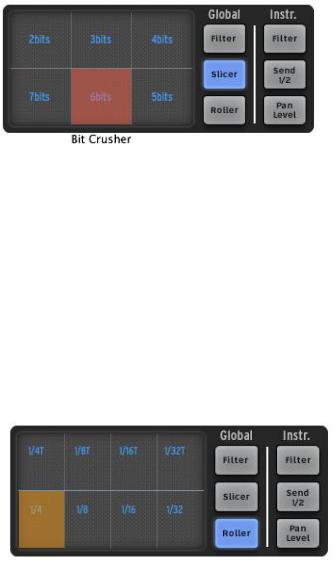
The Bit Crush effect allows you to reduce the audio bit rate, creating a bit-reduction or bit-crushing sound effect. Reduce the audio anywhere from 7 bits down to 2 bits.
Slicer example 3: Bit crusher options
Repeat mix
Click to choose a timing value for the Repeat mix effect. The effect will be applied for the amount of time your mouse click is maintained. Release your click to cancel and resume normal playing.
The Repeat Mix effect is different from the Repeat effect in that it will continue playing the entire pattern underneath the looped section.
5.2.5.3 The Roller button
The roller could be described as a "Drum roll" tool. It allows you to perform perfectly timed drum rolls easily from the pads, while also changing from one timing value to another by clicking on different areas of the FX Live pad.
Roller effect options
Choose the note value for the Roller effect from the choices in the FX Live pad area. Then, click and hold the snare drum pad. The snare drum will play a basic drum roll.
You can play any instrument pad using this effect. The beginning point of the roll is quantized by default.
A swing effect (dotted or triplet) can be added by selecting one of the upper set of note values, while the bottom set of values will be played ‘straight’.
When Swing dotted effect is on, a dotted beat is added after the first beat. When Triplet is on, three notes are played per note value.
‘Roller Swing Mode’ preference let you choose between dotted notes or triplet notes.
The Roller effect can be Latched to “On” by right-clicking on the Roller button. Now any pad you play will have the roll effect applied. This is a great way to enter notes into a pattern.
Note: The only way to trigger the Roller effect when the SparkLE controller is not connected is to use the Latch feature.
ARTURIA – SPARK CREATIVE DRUM MACHINE – USER’S MANUAL |
24 |
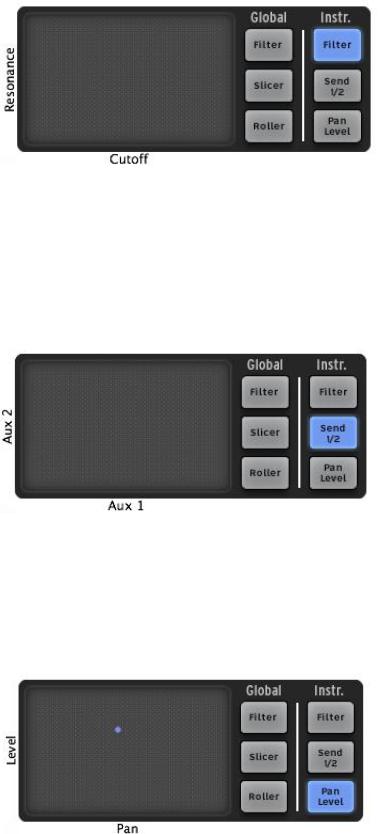
5.2.6 Live effects: Instrument
5.2.6.1 The Filter button
The Filter type for the kit is determined by the setting for the Global Filter button, but SparkLE allows you to apply this effect to one instrument at a time rather than the entire kit, if you like. To do this, select an instrument such as the snare (press Select + Instrument pad 2), then press the Instrument Filter button (pictured). Now the Live FX pad will alter the filter frequency and resonance for the snare only.
As you can see in the picture above, the X axis controls the filter’s cutoff frequency and the Y axis controls the resonance.
5.2.6.2 The Send 1 / 2 button
Similar to the process described above, you can single out one instrument for the live alteration of its Aux 1 and Aux 2 effect sends. If you want Tom 1 to have a sudden burst of reverb and/or delay, use the Select button to choose Instrument pad 5 and then press the Send 1 / 2 button (pictured). Then sweep your finger or cursor around inside the FX Live pad area and boost or cut Send 1 and/or Send 2 until you get the desired results.
The Y axis controls Send 1 and the X axis controls Send 2.
5.2.6.3 The Pan / Level button
The Instrument effect Pan / Level button allows you to control the stereo position and volume of a single Instrument inside a kit. So if you want to sweep the closed hi-hat
ARTURIA – SPARK CREATIVE DRUM MACHINE – USER’S MANUAL |
25 |

from the left side of the mix to the right, for example, press Select + Instrument pad 3 and then press the Pan / Level button. Then use the FX Live pad to place the hi-hat where you want it to be in the stereo field.
The X axis controls the instrument level and the Y axis controls the stereo position.
5.2.7 Song Mode in the Center panel
5.2.7.1 The Song button
Click on the Song button to enter the Song mode. The Song button will flash continuously to let you know that you are now in Song mode. Click on the Play button in the transport zone.
Listen! Your patterns are now chained together and played one after another in the sequence defined in the song panel.
The Step pads (numbered from 1 to 16 at the top of the Center Panel) are used to trigger the 16 pattern chains.
To edit your Song, refer to section 5.5 “The Song Panel”.
5.2.8 The Instrument Parameter knobs
The three knobs on the right side of the Center panel control the selected instrument's parameters. Let’s say you want to change the pitch of the bass drum. Click the bass drum pad. After this the Instrument Parameter knobs will show which three parameters have been selected for the bass drum: in this case, Pitch, Attack and Decay.
With a pattern playing, click and hold the "Pitch" knob and then move your cursor up and down. This will rotate the "Pitch" knob and change the pitch of the bass drum. The display will show the amount of change being applied to the pitch in terms of semitones.
5.2.8.1 Altering the Instrument Parameter assignments
It is possible to assign completely different parameters to the Instrument Parameter knobs. To change the assignment for the first knob, for example, click on the word “Pitch”. A drop-down list will appear. Make a selection from the list by clicking on one of the parameters. The list will disappear and the name of the new parameter will be visible under the knob.
ARTURIA – SPARK CREATIVE DRUM MACHINE – USER’S MANUAL |
26 |

5.2.9The Sequencer zone
The Sequencer zone is divided into several zones:
5.2.9.1 The Step Pad Function Select buttons (a)
When they are selected, these four buttons change what the Sequencer Step pads do:
Bank The first four Sequencer Step pads will be labeled A-D and the others will have no labels. This allows you to select between four different banks of 16 patterns
Patt. All 16 Sequencer Step pads will be numbered, and each will select one of 16 patterns
Seq. Each Sequencer Step pad will represent the presence or absence of a musical event in the selected instrument track, as well as the current position of the sequencer within the pattern (see section 5.2.9.3).
Tune The Sequencer Step pads will be labeled with numbers from -8 to +7, with each number representing the amount of tuning change that will be applied to the selected instrument after pressing its pad. The ‘0’ pad will return the instrument to its default pitch.
5.2.9.2 The Copy / Erase buttons (b)
These two buttons have very different functions:
Copy Allows you to copy a pattern from one location to another inside the same bank, or to a different bank to the same pattern number location. First click
‘Copy’ and select the source bank and pattern, and then select the destination pattern or bank and Spark will do the work. Press the Copy button again to cancel the operation.
Erase When pressed, the display will prompt you to select a pad, a pattern or a bank of patterns to erase.
o To erase a bank, press Erase and then select one of the banks (A-D)
o To erase a pattern, make sure you’re inside the proper bank before you press the Erase button. Then press Erase and select the pattern
ARTURIA – SPARK CREATIVE DRUM MACHINE – USER’S MANUAL |
27 |

oWhen a pad is selected, its entire sequencer track will be erased inside the current pattern
oFor “spot erase” while a pattern is playing, press the Record button, then the Erase button, and then press the instrument pad at the proper time.
5.2.9.3The Pattern Length buttons (c)
These buttons fulfil two functions: while the pattern is not playing they can toggle between the currently selected set of steps and the next (1-16 or 17-32, etc.). But when used in conjunction with the Select button they allow you to change the pattern length (which can be done while the pattern is running).
When a pattern contains more than 16 steps the Sequencer Step pads can follow the position of the pattern when it crosses over from steps 1-16 to steps 17-32, and then to steps 33-48, etc. This is called “Sequencer Follow mode”. To toggle this feature on or off, simply press the << and >> buttons at the same time.
5.2.9.4 The Loop mode controls (d)
Patterns are always looping, so “Loop mode” means something else: It allows you to set up a “loop within a loop” and experiment with different portions of the pattern, either for editing or performing. Here are its components:
On Will engage or disengage Loop mode.
Divide Allows you set the loop size. Moving it one notch will cut the loop in half or double its size (when possible). The settings are 1/2, 1/4 and 1/8 of the pattern size, all the way down to the minimum loop size: one step.
Move Will move the loop start in one of two ways. Right-click on the Move knob to choose an option:
o“Shift by one step” will shift the loop start point to any given step of the pattern
o"Shift by one loop size" will move the loop start point in increments of the loop size (as defined by the Divide knob).
5.2.9.5 The Sequencer Step pads (e)
The 16 Sequencer Step pads can be numbered from 1-16, 17-32, 33-48, or 49-64 depending on the length of the pattern and the timing value assigned to each step.
These pads offer a lot of information about the selected pattern. When a pattern is playing you will know the real-time playing position at a glance because it is indicated by a pad that is brighter than the others. When a pad has a constant blue light it means the sequencer will trigger the selected instrument at this position in the pattern. If a pad is not lit, it means no note will be played by that instrument at that point. You can decide to add a note-on event or remove one by toggling the state of these pads.
A simple example is the bass drum track on pattern A1, which is pictured below. The bright blue lights on pads 1 and 9 indicate bass drum events on beats 1 and 3 of the first bar. The gray light on pad 4 is lighter than the others, which indicates the current realtime playing position.
ARTURIA – SPARK CREATIVE DRUM MACHINE – USER’S MANUAL |
28 |
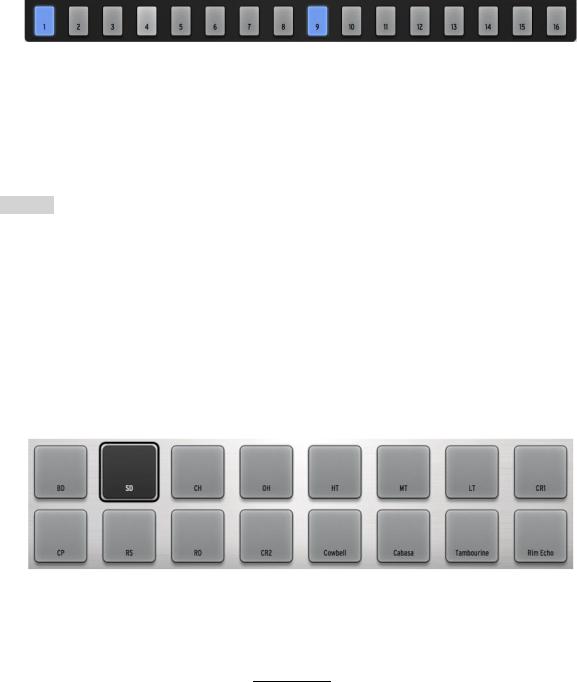
You can edit this track by pressing a pad to add a bass drum event to the pattern. While the pattern plays, click on pads 7 and 15. They will become lit, and you will hear new bass drum events during the first bar of the pattern. Now click on pad 9: the blue light turns to darker gray, and that note has been removed from the pattern.
5.2.9.6Copying or Swapping Patterns
You can also use the Sequencer Step pads to copy or swap patterns in the currently selected bank.
To copy a pattern to another location, click on a pattern number and then drag it on top of another pattern and drop it. A confirmation window will appear. Remember, this will replace the destination pattern with the source pattern, so if you’re sure it’s okay to lose the destination pattern, click OK.
To swap two patterns, click on a pattern number while holding [Option/Alt in Mac OSX or [Ctrl in Windows and then drag it on top of another pattern and drop it. A confirmation window will appear. Click Ok.
The exact same procedure applies to copying or swapping entire banks of patterns.
To export a pattern as a MIDI file to your system or to your DAW, drag the pattern outside the Spark window and drop it on a system folder or one of the DAW windows.
5.2.10 The Pads
An instrument is assigned to each of the 16 pads. The far left pad is by default the Bass Drum; next to it is the Snare drum, and so on; but you can set the pads up in any order you like.
To edit an instrument, right-click on the pad and then click Edit. This will take you to the "Studio" inside the Bottom panel where you will be able to edit the instrument with a full array of parameters. (See section 5.6 The Studio).
One really cool feature is the ability to import your own samples into the Spark Engine by dragging them from a folder on your computer and dropping them onto one of the sixteen pads. From there you can right-click as described above so you can shape the sound of the new sample using the powerful voice architecture of the Spark Engine.
5.2.10.1 Tune Mode
Pressing “Tune” allows you to play the selected instrument at different pitches using the
Sequencer Step pads, numbered from -8 to +7.
To do this, locate the Tune mode preference in the Top panel’s Preference section and set it to “Pads” instead of “Sequencer Steps.”
You can now use the pads as a keyboard to play notes on the current instrument. The pads offer a range of 16 semi-tones by using the 1-8 / 9-16 button:
With the 1-8 / 9-16 button unlit you can play notes from the current instrument tuned from -8 semi-tones to -1 semi-tone.
ARTURIA – SPARK CREATIVE DRUM MACHINE – USER’S MANUAL |
29 |
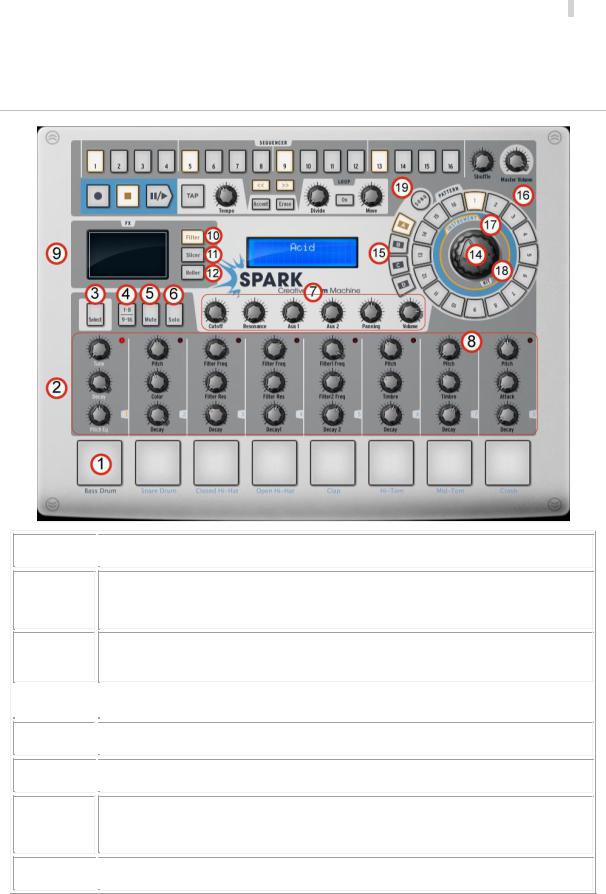
With the 1-8 / 9-16 button lit you can play notes from current instrument pitch upward to +7 semi-tones.
You can offset the starting pitch by moving the Jog Dial when you are in Tune mode.
5.3 THE MAIN PANEL (SPARK CREATIVE)
1.
 Play instruments with pads (right-click: edit the instrument)
Play instruments with pads (right-click: edit the instrument)
2.Instrument parameter knobs (right-click: edit motion/disable motion)
3.Instrument Select / Shortcut Select button (Hold select, then press an instrument pad or sequencer step pad)
4 |
|
Instrument page button (Instruments 1-8 and 9-16) |
|
|
|
5.
 Mute button (Click Mute, then select one or more instruments)
Mute button (Click Mute, then select one or more instruments)
6.
 Solo button (Click Solo, then select one or more instruments)
Solo button (Click Solo, then select one or more instruments)
7.FX – Aux 1 and 2 – Pan and volume Knobs (right-click: edit motion/disable motion)
8.
 Click within a zone to select instrument track
Click within a zone to select instrument track
ARTURIA – SPARK CREATIVE DRUM MACHINE – USER’S MANUAL |
30 |
